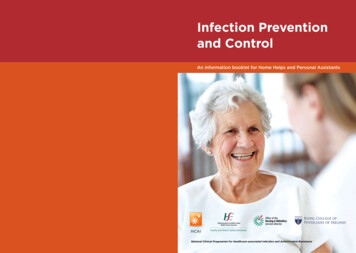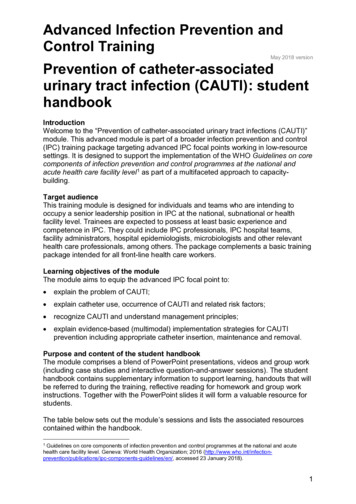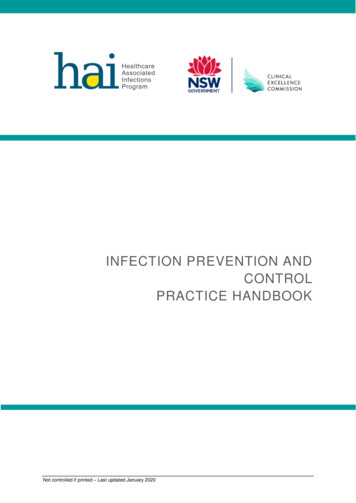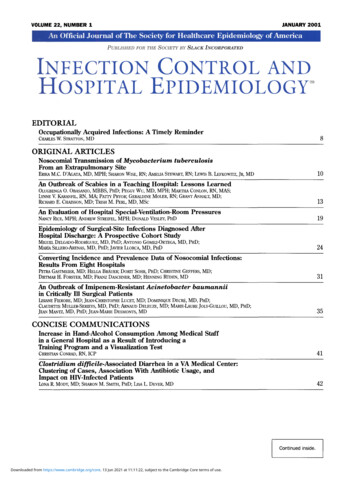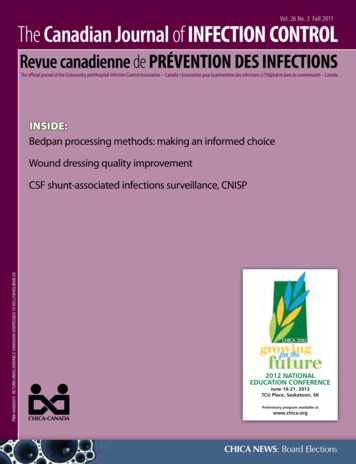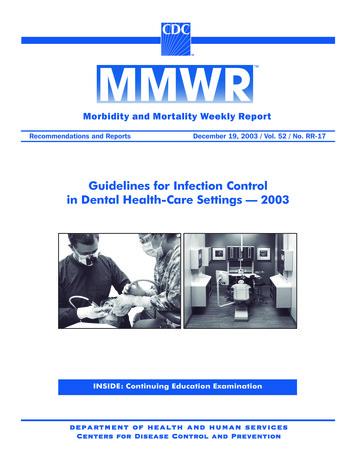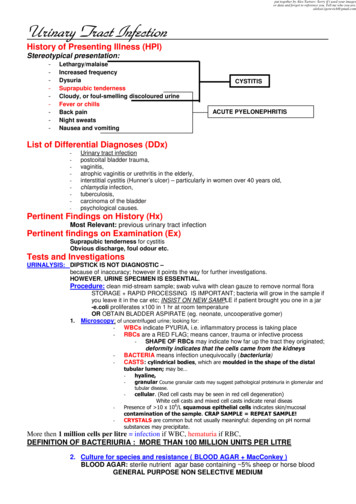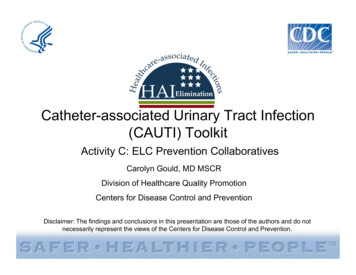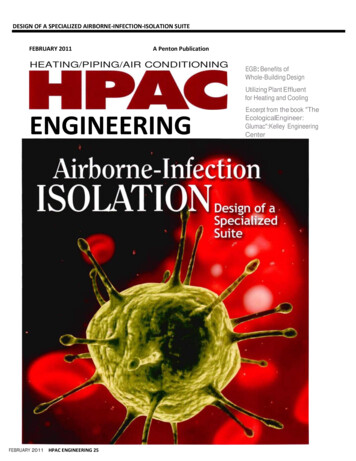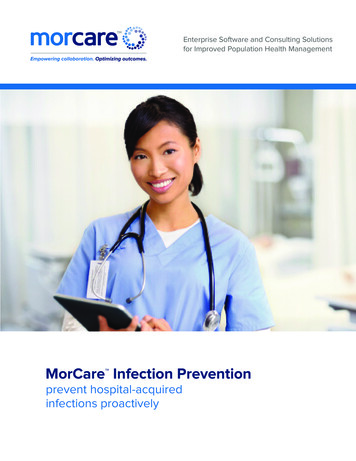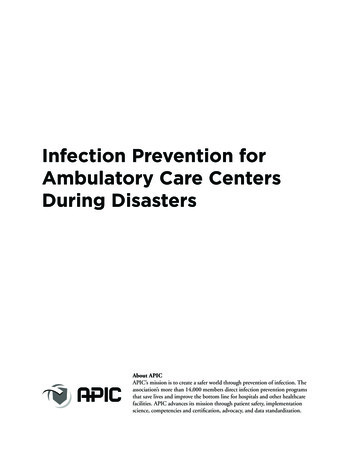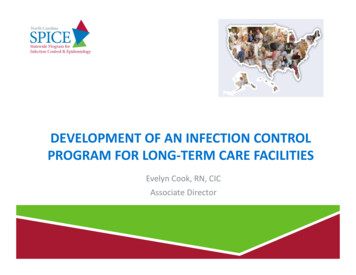
Transcription
DEVELOPMENT OF AN INFECTION CONTROLPROGRAM FOR LONG‐TERM CARE FACILITIESEvelyn Cook, RN, CICAssociate Director
Need for long‐term care Long‐term care is characterized by medical,personal, social, and psychological care overextended time periods. The need for long‐term care is not necessarilyidentified with particular diagnoses, but ratherphysical or mental disabilities that impairfunctioning in activities necessary for daily living. Although such conditions affect individuals of allages, the need for long‐term care stronglyincreases with age.An overview of long‐term care:Pamela Doty, Korbin Liu, and Joshua Wiener
Demographics 2013 CMS reported (in CMS certified LTCGs)85% of LTC residents were 65 years or olderwith 43% being 85 or older. Population aged 85 and older is expected todouble by the year 2030 One out of every four persons aged 65 willspend some time in a nursing home More people in long term care facilitiesthan hospitals
Objectives1. Describe the problem of healthcareassociated infections in LTCFs2.3.4.List the factors contributing to infections inthe elderlyDescribe regulatory factors impacting LTCFsDescribe the components of a LTCFinfection prevention program
Healthcare associated infections (HAI)Long Term Care Facilities (LTCFs) Limited data Published rates vary from 1.4 to 5.2 infections per1,000 resident‐care days Nationally a range of 765,000 to 2.8 millioninfections/annuallyNorovirus RespiratoryillnessSkin/SoftTissue
Healthcare associated infections (HAI)long term care Facilities (LTCFs) Account for 26% of all serious adverse events 59% deemed preventable Among the most frequent causes of transfer toacute care hospitals and 30‐day hospitalreadmissions. Cost of infection‐related hospitalizations wasestimated to be 83 million in single monthOIG. Adverse Events in Skilled Nursing Facilities: National Incidence Among MedicareBeneficiaries, OEI‐06‐11‐00370, February 2014
Healthcare‐associated infectionsin U.S. nursing homes Pilot study done in nine(9) nursing homes Four (4) states Nursing homes 120beds Findings presented atCouncil of State andTerritorial Epidemiologist(CSTE) annual conference(6/16/2015)PrevalencePer 100Residents# tory1.316UTI0.56Other0.11BSI00
Prevalence survey of healthcare‐associated infections andantimicrobial use in U.S. nursing homes(Part B) Data collection begin spring/summer of 2017 Goal is to recruit a random sample of 20 nursing homes in each ofthe 10 EIP states Nursing homes certified by CMS are eligible Nursing home participation is voluntary Based on the long‐standing relationships that EIP sites have withtheir healthcare facilities, we (CDC) anticipate that we will meetour 2017 recruitment goals. Findings reported 2018Emerging Infections Program Healthcare Associated Infections –Community Interface
Elements Required for an infection Chain of Infection: Infectious agentReservoirPortal of ExitPortal of EntryMeans of TransmissionSusceptible hostChain ofInfection All of these factors are present in LTCFs Almost as many HAIs occur annually in LTCFs asacute care hospitals in the US
Specific Infections in the LTCFs Urinary Tract Infection (account for 30% of hospitalreadmissions within 30 days) Number 1 (but is it really?) Respiratory Tract Infection(Pneumonia 5th leading cause of death in patients 65) Probably # 1 Influenza, RSV, Coronavirus, Pneumonia, TB Skin and soft‐tissue infections (infestations) Decubitus ulcers, Cellulitis, Scabies
Specific Infections in the LTCFs Gastroenteritis (Pennsylvania C diff #1cause of diarrhea) Clostridium difficile, Norovirus Conjunctivitis Bacteremia (50% related to UTI) Resurgence of “pediatric” infections in theLTCF: Pertussis, RSV, H influenza
Specific Infections in the LTCFs Antibiotic‐resistant bacteria MRSA (methicillin‐resistant staphylococcusaureus) VRE (vancomycin‐resistant enterococci) Resistant S pneumoniae Multi‐drug resistant gram negative bacteria Pseudomonas aeruginosa Acinetobacter spp ESBL producers Carbapenem resistant enterobacteriaceae
Blood Glucose Monitoring and Risks forBloodborne Pathogen TransmissionPhoto courtesy of the Statewide Program for Infection Control andEpidemiology (SPICE) at the University of North Carolina
Part of the Problem No SENIC (Study on the Efficacy of NosocomialInfection Control)‐equivalent study for LTCFs Few controlled studies have analyzed efficacyor cost‐effectiveness of infection controlmeasures in LTCF
Objectives1.Describe the problem of healthcareassociated infections in LTCFs2. List the factors contributing toinfections in the elderly3.4.Describe the regulatory factors impact onLTCFsDescribe the components of a LTCFinfection prevention program
Contributing Factors LCTFs are different from other healthcaresettings in that elderly patients at increasedrisk for infection, are brought together in onesetting and remain in the facility for extendedperiods of time; for most residents, it is theirhome.
Contributing factors An atmosphere of community is fostered andresidents share common eating and livingareas, and participate in various facility‐sponsored activities Since able residents interact freely with eachother, controlling transmission of infection inthis setting is challenging
Contributing factors Residents who are colonized or infected withcertain microorganisms are, in some cases,restricted to their room. However, because of the psychosocial risksassociated with such restriction, it has beenrecommended that psychosocial needs bebalanced with infection control needs in the LTCFsetting
Individual FactorsContributing to infections Medications affecting resistance to infection(corticosteroids and chemotherapy) Limited physiologic reserve Compromised host defenses ( cough reflex, thinning skin,decreased tear production and immune dysfunction) Coexisting chronic diseases Complications from invasive diagnostic procedures Impaired responses to infection Increased frequency of therapeutic toxicity (declining liverand kidney function)
Additional Contributing Factors Nurse (staff turnover) Published data on overall high employee turnoverrates in LTC facilities; 2011 data from the QualityLong Term Care Commission showed the followingturnover rates: Administrators, 3 percent; Director of nursing, 39 percent RNs, 50 percent LPNs, 49 percent and CNAs, 71 percentInfection Prevention in LTC: Emphasis Needed on Education, Evidence-Based Practices; Infection Control Today:Gail Bennett, RN, MSN, CIC, Rome, GA ICP Associates, Inc.
One Size Doesn’t Fit AllInfection Preventionist ViewLong Term Care Residents have multiple co‐morbidities Resources more limited(equipment, staff) Staff and residentsreceptive to receivinginfection preventioneducation (Improved IP jobsatisfaction) Long term relationshipsformed with residents andfamily membersAcute Care Address the acute issue athand More staff at various levelsof education, technologyand equipment Often staff view IP as thePOLICE Interactions with patientsand families are shorter andmore limited.
Objectives1.2.Describe the problem of healthcareassociated infections in LTCFsList the factors contributing to infections inthe elderly3. Describe the regulatory factors impacton LTCFs4.Describe the components of a LTCFinfection prevention program
Regulatory and/or AccreditingAgencies OSHA (Occupational Safety and HealthAdministration) OBRA (Omnibus Budget Reconciliation Act) CMS TJC (The Joint Commission)
Regulatory Responsibilities OSHA is responsible for employees/healthcare workersNOT patients CMS/DHSR is responsible for patientsNOT healthcare workers
Regulatory Focus ‐ OSHA Occupational Exposure to Bloodborne Pathogens: FinalRule, December 6, 1991 Occupational Injury and Illness Recording and ReportingRequirements; Final Rule, January 19, 2001 CPL 2‐2.69 Subject: Enforcement Procedures for theOccupational Exposure to Bloodborne Pathogens, Nov27, 2001 TB Compliance Directive ‐ reflects 1994 CDC Guidelinesfor Control and Prevention of TB in Health CareFacilities, February 9, 1996
State Regulations Impacting LTCFs Rules Governing the Sanitation of Hospitals, Nursingand Rest Homes, Sanitariums, Sanitoriums and OtherInstitutions ‐ 15A NCAC 18A .1300 (Available html NC Communicable Disease Rule 10A NCAC 41A .0206.Adopted by the Commission for Health Services onAugust 5, 1992. Infection Control in Health CareFacilities. Requires a written infection control policyand a staff member trained in infection control. NC Rules for the Licensing of Nursing Homes and Bedsin Homes for the Aged Licensed as Part of a NursingHome
Federal Regulations and StandardsThat Govern LTCFs Federal regulations specific to all LTCF. TheFederal Omnibus Budget Reconciliation Act of1987 (OBRA): Subtitle C ‐ Nursing HomeReform includes changes in LTCF managementand provision of services which include orimpact infection control including: Requirement for sanitation, infection control, and physical environment
FEDERAL REGISTERVOL. 81TuesdayNO. 192October 4th, 2016
DHHS Federal Amendments That Apply toPrograms Title XVIII Medicare and XIX Medicaid(Interpretive Guidelines)§F483.80 Infection ControlFacility must establish and maintain aninfection prevention and control programdesigned to provide a safe, sanitary, andcomfortable environment and to helpprevent the development and transmissionof communicable diseases and infections.
NATIONAL ACTION PLAN TO PREVENT HEALTH CARE‐ASSOCIATEDINFECTIONS: ROAD MAP TO ELIMINATION APRIL 2013 Five areas of targeted focus and goals: NHSN enrollment Goal: 5% of CNHs within 5 years period Urinary Tract Infections/CAUTIs Goal: Pilot reporting to NHSN, evaluate variability, and obtain consensus onmeasurable five‐year goal. Clostridium difficile infection (CDI) Goal: Pilot reporting to NHSN, evaluate variability, and obtain consensus onmeasurable five‐year goal. Resident influenza and pneumococcal vaccination Goal: 85% vaccinated with 5 years Healthcare personnel influenza vaccination Goal: In alignment with the previous Influenza Vaccination of HCP chapter,75% of HCP in long‐term care receive the seasonal influenza vaccination plan‐ltcf.pdf
Objectives1.2.3.Describe the problem of healthcareassociated infections in LTCFsList the factors contributing to infections inthe elderlyDescribe the regulatory factors impact onLTCFs4. Describe the components of a LTCFinfection prevention program
Shea/apic guideline:infection prevention and control in the long‐term care facility In this document, as in a number ofpublished HICPAC, SHEA, and APICguidelines, each recommendation iscategorized on the basis of existing scientificevidence, theoretical rationale, applicability,and national or state regulationsSmith et al; AJIC September 2008
Categorization ofRecommendations Category IA: Strongly recommended andstrongly supported Category IB: Strongly recommended withsome support Category IC: Required by law/regulation Category II: Recommended forimplementation No Recommendation: Unresolved issues
LTCF Infection Prevention Program An active, effective, facility‐wide infectionprevention program should be established inthe LTCF. The Purpose of the program is toreduce the risk of development and spread ofinfectious disease (Cat1C) The IP Program must be in compliance withfederal, state and local regulations (Cat 1C)
Program Elements Surveillance Outbreak Control Isolation Policies and procedures Education Resident HealthProgram Employee HealthProgram Antibiotic Stewardship Communicable diseasereporting Facility Management PI/Safety Preparedness planning
Administrative Structure Oversight of the IP program should be definedand should include participation of the IP,administration, nursing staff, and physician staff(Category II) Meet on regular basis Written minutes with action plans andrecommendations Evaluate effectiveness Review of IP data Approve policies and procedures
Infection Control Committee regulatoryrequirement was dropped by OBRA at thefederal level but some states still require it. Combined with PI, safety etc Consultation should be available as needed: ID physician Professional with expertise in IP
Infection Preventionist One person should be assigned the responsibility ofdirecting IP activities (usually the IP). Should besomeone familiar with LTCF resident care problems(Category IC) Usually a staff nurse (nursing, med tech or microbiologybackground) Responsibilities may often be (or is always) combined with otherjobs (occupational health, quality management, staff education) Responsible for implementing, monitoring and evaluating theinfection control program Requires specific training Well‐defined support from administration (education andresources) Ability to interact tactfully with personnel, physician, and residents
The IP (or another appropriate individual suchas the medical director) should have writtenauthority to institute infection preventionmeasures in emergency situations (CategoryIB) Examples: Isolate residents, not allow employeesto work if sick etc.
Infection Control Hours Is the time given to the IP adequate for thesize of the facility, acuity of the residents, andtypes of procedures and treatment? No specific amount of time has beenresearched to be ideal; the following guidelinehas been developed based on experience
Infection Control HoursNo of beds1‐5051‐100101‐150151‐200more than 200Hours per week for IC816243240Ref: Mark JF, APIC LTCF Newsletter, 1995, vol 6, no 1
Education for IP The importance of education of the LTCF IP has beendemonstrated Study of participants in 2 day basic training coursedemonstrated increase in post course knowledge Study of participants at 3 and 12 month follow‐up showedstatistically significant increase in implementation of keyinfection control practices (performance of surveillance, usinginfection definitions, calculating infection rates, givingemployees and residents TB skin tests and influenza vaccines
Surveillance in LTCF The LTCF should have a system for ongoing collection ofdata on infections in the institution (Cat IC) Process and/or Outcome Surveillance Standardized Definitions Listing of symptoms or criteria Surveillance tools Surveys, data collection templates, walking rounds Analyzing those healthcare associated (facility‐acquired) Detect clusters, trends Resident identifier Type of infection, onset, location and lab data
Surveillance in LTCF Infection rates (outcome measures)should be calculated: Calculated preferably as infections per 1000 resident days# of infectionsX 1000 rate of infections/1000 resident days# of resident days Reported out: monthly, quarterly and annually Developing a plan of action to reduce problems Process measures Compliance with hand hygiene Compliance with use of PPE Compliance with indwelling catheter care and maintenance
Infection Prevention RiskAssessment Components:– Risk Event Geographic location Infections Environmental issues– Probability risk will occur High, Medium, Low or None– Severity if the risk occurs Life threatening, Permanent harm, Temporary nt‐tool
Infection Control risk assessment– How well prepared is the organization if the riskoccurs Poorly Fairly well Well– Risk Score Assign a numerical value to each of the above Add or multiply Scores with highest number is prioritized.Update no less than annually; use as a tool to evaluate yourinfection prevention and control program and goals
Oklahoma State Dept. of Health
Recognizing and containing outbreaks An outbreak is typically one or more of the following:– One case of an infection that is highly communicable– Trends that are 10% higher than the historical rate of infectionfor the facility– Occurrence of three or more cases of the same infection over aspecified length of time on the same unit or other defined areasGuidance to Surveyors: Long‐Term Facilities
Outbreak Control Surveillance data should be used to detect andprevent outbreaks in the LTCF (Cat IB/IC) State health departments offer guidance andregulations regarding responding to and reportingoutbreaks (NCDPH considers 2 or more cases anoutbreak) Policies and protocols for prevention andinvestigation need to be in place Prevent further transmission while consideringthe needs of all residents and staff
Isolation and Precautions for LTCF Isolation and precautions policies and proceduresshould be developed, evaluated, and updated inaccordance with most recent CDC/HICPAC guidance(Cat IC) Isolation and precautions systems are an important meansfor preventing cross‐infection Standard Precautions for all residents Transmission‐based precautions in accordance with guidelines Contact, droplet and airborne Compliance should be monitored (Process measure)
Isolation and Precautions for LTCF(cont) Each LTCF needs to have a policy dealing withMDROs that is compatible with current guidelines adapt the aspects of CDC isolation system that apply to itsneeds Incorporate individual state guidelines (whenappropriate) (i.e. medical waste rules) Isolation and precaution policies need to defineauthority The nurse should have the authority to initiateprecautions in an emergency without a physician’s order
Policies and Procedures Should be developed for each department andservice in the facility (housekeeping, physicaltherapy, respiratory care, dietary, laundry, woundcare, pet therapy) Need to reflect current and actual practice(reviewed every 3 years) Use published guidelines from governmentalagencies (i.e., CDC, OSHA, FDA, EPA, USP)
Asepsis and Hand Hygiene Hands should be washed before and after anypatient contact, after removing gloves, whensoiled and when otherwise indicated (Cat IA) Unless hands are visible soiled, use of alcohol‐based hand gels is encouraged Policy in accordance with CDC guidelines Compliance monitored Data and findings reported to staff
Resident Care Rooms should have accessible sink with soap,water towels and toilet facilities Skin care program Program to prevent UTIs Routine UA/culture to screen not recommended Program to minimize the risk of pneumonia andLRTI (oral hygiene and pneumonia guidelines)
Resident Health A resident health program should beimplemented H&P on admission with immunization status TB screening (2 step and CXR if positive) Vaccine for tetanus, diphtheria, influenza,pertussis, pneumococcal pneumonia Policies and procedures addressing visitors (whento limit)
Influenza Vaccination Between 13‐34% of skilled nursing facilities report aninfluenza outbreak annually Influenza vaccination of HCP associated with 30‐40%reduction in mortality of nursing home residents 60% influenza virus infections can be prevented when100% of HCP are vaccinated Even with above in the last 3 years only an estimated50‐65% of HCP in LTCF receive the vaccine
§483.80(d) Influenza andPneumococcal Immunizations Influenza: Facility must develop policies and procedures toensure that:––––Before offering, education providedOffered between October 1‐March 31 annuallyRight to refuseDocumentation Pneumococcal disease: Facility must develop policies andprocedures to ensure that:––––Before offering, education providedOffered unless already immunized or medically contraindicatedRight to refuseDocumentation
Employee Health All new employees should have a baselinehealth assessment, including immunizationstatus TST at time of hire (2‐step if indicated) Follow up TST based on risk assessment Immunizations as recommended Influenza HBV, Tetanus (tdap) Managing employee illness and exposurefollow‐uphttp://epi.pu
May 02, 2018 · Usually a staff nurse (nursing, med tech or microbiology background) Responsibilities may often be (or is always) combined with other jobs (occupational health, quality management, staff education) Responsible for implementing
